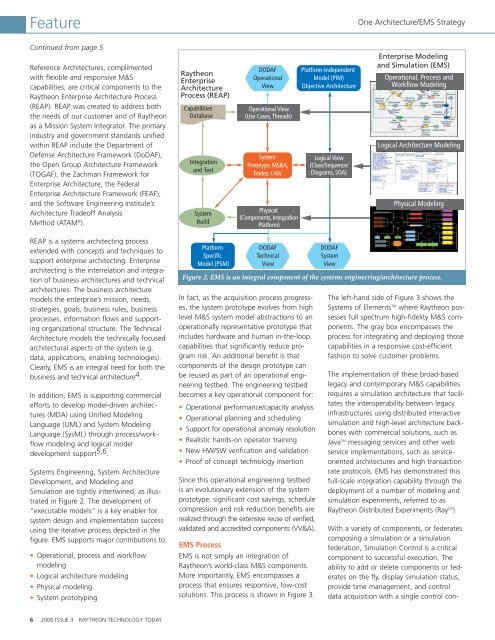Technology Today 2006 Issue 3 - Raytheon
Technology Today 2006 Issue 3 - Raytheon
Technology Today 2006 Issue 3 - Raytheon
Create successful ePaper yourself
Turn your PDF publications into a flip-book with our unique Google optimized e-Paper software.
Feature<br />
Continued from page 5<br />
Reference Architectures, complimented<br />
with flexible and responsive M&S<br />
capabilities, are critical components to the<br />
<strong>Raytheon</strong> Enterprise Architecture Process<br />
(REAP). REAP was created to address both<br />
the needs of our customer and of <strong>Raytheon</strong><br />
as a Mission System Integrator. The primary<br />
industry and government standards unified<br />
within REAP include the Department of<br />
Defense Architecture Framework (DoDAF),<br />
the Open Group Architecture Framework<br />
(TOGAF), the Zachman Framework for<br />
Enterprise Architecture, the Federal<br />
Enterprise Architecture Framework (FEAF),<br />
and the Software Engineering Institute’s<br />
Architecture Tradeoff Analysis<br />
Method (ATAM ® ).<br />
REAP is a systems architecting process<br />
extended with concepts and techniques to<br />
support enterprise architecting. Enterprise<br />
architecting is the interrelation and integration<br />
of business architectures and technical<br />
architectures. The business architecture<br />
models the enterprise’s mission, needs,<br />
strategies, goals, business rules, business<br />
processes, information flows and supporting<br />
organizational structure. The Technical<br />
Architecture models the technically focused<br />
architectural aspects of the system (e.g.<br />
data, applications, enabling technologies).<br />
Clearly, EMS is an integral need for both the<br />
business and technical architecture 4 .<br />
In addition, EMS is supporting commercial<br />
efforts to develop model-driven architectures<br />
(MDA) using Unified Modeling<br />
Language (UML) and System Modeling<br />
Language (SysML) through process/workflow<br />
modeling and logical model<br />
development support 5,6 .<br />
Systems Engineering, System Architecture<br />
Development, and Modeling and<br />
Simulation are tightly intertwined, as illustrated<br />
in Figure 2. The development of<br />
“executable models” is a key enabler for<br />
system design and implementation success<br />
using the iterative process depicted in the<br />
figure. EMS supports major contributions to:<br />
Operational, process and workflow<br />
modeling<br />
Logical architecture modeling<br />
Physical modeling<br />
System prototyping<br />
6 <strong>2006</strong> ISSUE 3 RAYTHEON TECHNOLOGY TODAY<br />
<strong>Raytheon</strong><br />
Enterprise<br />
Architecture<br />
Process (REAP)<br />
Capabilities<br />
Database<br />
Integration<br />
and Test<br />
System<br />
Build<br />
Platform-<br />
Specific<br />
Model (PSM)<br />
DODAF<br />
Operational<br />
View<br />
Operational View<br />
(Use Cases, Threads)<br />
System<br />
Prototype, MS&A,<br />
Trades, CAIV<br />
Physical<br />
(Components, Integration<br />
Platform)<br />
DODAF<br />
Technical<br />
View<br />
In fact, as the acquisition process progresses,<br />
the system prototype evolves from high<br />
level M&S system model abstractions to an<br />
operationally representative prototype that<br />
includes hardware and human in-the-loop<br />
capabilities that significantly reduce program<br />
risk. An additional benefit is that<br />
components of the design prototype can<br />
be reused as part of an operational engineering<br />
testbed. The engineering testbed<br />
becomes a key operational component for:<br />
Operational performance/capacity analysis<br />
Operational planning and scheduling<br />
Support for operational anomaly resolution<br />
Realistic hands-on operator training<br />
New HW/SW verification and validation<br />
Proof of concept technology insertion<br />
Since this operational engineering testbed<br />
is an evolutionary extension of the system<br />
prototype, significant cost savings, schedule<br />
compression and risk reduction benefits are<br />
realized through the extensive reuse of verified,<br />
validated and accredited components (VV&A).<br />
EMS Process<br />
EMS is not simply an integration of<br />
<strong>Raytheon</strong>’s world-class M&S components.<br />
More importantly, EMS encompasses a<br />
process that ensures responsive, low-cost<br />
solutions. This process is shown in Figure 3.<br />
Platform-Independent<br />
Model (PIM)<br />
Objective Architecture<br />
Logical View<br />
(Class/Sequence/<br />
Diagrams, SOA)<br />
DODAF<br />
System<br />
View<br />
One Architecture/EMS Strategy<br />
Enterprise Modeling<br />
and Simulation (EMS)<br />
Operational, Process and<br />
Workflow Modeling<br />
Logical Architecture Modeling<br />
Physical Modeling<br />
Figure 2. EMS is an integral component of the systems engineering/architecture process.<br />
The left-hand side of Figure 3 shows the<br />
Systems of Elements TM where <strong>Raytheon</strong> possesses<br />
full spectrum high-fidelity M&S components.<br />
The gray box encompasses the<br />
process for integrating and deploying those<br />
capabilities in a responsive cost-efficient<br />
fashion to solve customer problems.<br />
The implementation of these broad-based<br />
legacy and contemporary M&S capabilities<br />
requires a simulation architecture that facilitates<br />
the interoperability between legacy<br />
infrastructures using distributed interactive<br />
simulation and high-level architecture backbones<br />
with commercial solutions, such as<br />
Java TM messaging services and other web<br />
service implementations, such as serviceoriented<br />
architectures and high transaction<br />
rate protocols. EMS has demonstrated this<br />
full-scale integration capability through the<br />
deployment of a number of modeling and<br />
simulation experiments, referred to as<br />
<strong>Raytheon</strong> Distributed Experiments (Ray DX ).<br />
With a variety of components, or federates<br />
composing a simulation or a simulation<br />
federation, Simulation Control is a critical<br />
component to successful execution. The<br />
ability to add or delete components or federates<br />
on the fly, display simulation status,<br />
provide time management, and control<br />
data acquisition with a single control con-

















